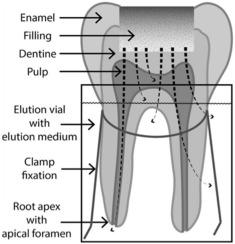当前位置:
X-MOL 学术
›
Dent. Mater.
›
论文详情
Our official English website, www.x-mol.net, welcomes your
feedback! (Note: you will need to create a separate account there.)
An alternate methodology for studying diffusion and elution kinetics of dimethacrylate monomers through dentinal tubules.
Dental Materials ( IF 4.6 ) Pub Date : 2020-02-21 , DOI: 10.1016/j.dental.2020.02.008 Jürgen Durner 1 , Klaus Schrickel 2 , David C Watts 3 , Marc Becker 1 , Reinhard Hickel 4 , Miriam E Draenert 4
Dental Materials ( IF 4.6 ) Pub Date : 2020-02-21 , DOI: 10.1016/j.dental.2020.02.008 Jürgen Durner 1 , Klaus Schrickel 2 , David C Watts 3 , Marc Becker 1 , Reinhard Hickel 4 , Miriam E Draenert 4
Affiliation

|
OBJECTIVE
Ethoxylated bisphenol A dimethacrylate (bisEMA) is a base monomer in several dental resin composites. It was the main aim of the present study to determine if bisEMA can reach the dental pulp by generally passive diffusion through the coronal dentinal tubules stimulated via eluent liquids surrounding the root structures only.
METHODS
In 20 human third molar teeth, standard Class-I occlusal cavities were prepared and provided either with an adhesive system alone or additionally with a composite restoration, according to the instructions of the manufacturer. The teeth were placed in an elution chamber such that the elution media only came into contact with the tooth root/tooth base where they were incubated at 37 °C for up to 7 d. Samples were taken after 1, 2, 4 and 7 d. Gas chromatography/mass spectrometry was used to identify bisEMA and other monomers in ethanol/water (3:1) and aqueous eluates.
RESULTS
bisEMA was only found in ethanol/water eluates, where the teeth had received a composite restoration. Traces of bisEMA with up to three ethylene oxide units could be detected in these eluates. Depending on the dentin thickness, different elution kinetics of bisEMA were determined. Regardless of the treatment of teeth, triethylene glycol dimethacrylate (TEGDMA) and tetraethylene glycol dimethacrylate (TEEGDMA) were found in ethanolic/aqueous eluates in equal amounts. Most TEGDMA and TEEGDMA diffused through the dentin within the first 24 h.
SIGNIFICANCE
Depending on the dentin layer thickness, bisEMA was released for varied time periods, resulting in varied concentrations and exposure times for the different cells of the dental pulp. The concentrations of TEGDMA and TEEGDMA were greatest for cells of the dental pulp within the first 24 h.
中文翻译:

研究二甲基丙烯酸酯单体通过牙本质小管扩散和洗脱动力学的另一种方法。
目的乙氧基化双酚A二甲基丙烯酸酯(bisEMA)是几种牙科树脂复合材料的基础单体。本研究的主要目的是确定bisEMA是否可以通过通常仅通过围绕根部结构的洗脱液刺激的冠状牙本质小管的被动扩散而到达牙髓。方法根据制造商的说明,在20颗人类第三颗磨牙中,准备了标准的Class-I咬合腔,并单独提供了胶粘剂系统或另外提供了复合修复体。将牙齿放在洗脱室中,使洗脱介质仅与齿根/齿根接触,然后在37°C下孵育7 d。在1、2、4和7天后取样。气相色谱/质谱法用于鉴定乙醇/水(3:1)和水洗脱液中的bisEMA和其他单体。结果bisEMA仅在乙醇/水洗出液中发现,那里的牙齿接受了复合修复。在这些洗脱液中可以检测到痕量的带有多达三个环氧乙烷单元的bisEMA。根据牙本质的厚度,确定了bisEMA的不同洗脱动力学。无论牙齿如何处理,在乙醇/水性洗出液中均发现三乙二醇二甲基丙烯酸酯(TEGDMA)和四乙二醇二甲基丙烯酸酯(TEEGDMA)。在最初的24小时内,大多数TEGDMA和TEEGDMA通过牙本质扩散。意义取决于牙本质层的厚度,bisEMA的释放时间不同,导致牙髓不同细胞的浓度和暴露时间不同。在最初的24小时内,牙髓细胞的TEGDMA和TEEGDMA浓度最高。
更新日期:2020-02-21
中文翻译:

研究二甲基丙烯酸酯单体通过牙本质小管扩散和洗脱动力学的另一种方法。
目的乙氧基化双酚A二甲基丙烯酸酯(bisEMA)是几种牙科树脂复合材料的基础单体。本研究的主要目的是确定bisEMA是否可以通过通常仅通过围绕根部结构的洗脱液刺激的冠状牙本质小管的被动扩散而到达牙髓。方法根据制造商的说明,在20颗人类第三颗磨牙中,准备了标准的Class-I咬合腔,并单独提供了胶粘剂系统或另外提供了复合修复体。将牙齿放在洗脱室中,使洗脱介质仅与齿根/齿根接触,然后在37°C下孵育7 d。在1、2、4和7天后取样。气相色谱/质谱法用于鉴定乙醇/水(3:1)和水洗脱液中的bisEMA和其他单体。结果bisEMA仅在乙醇/水洗出液中发现,那里的牙齿接受了复合修复。在这些洗脱液中可以检测到痕量的带有多达三个环氧乙烷单元的bisEMA。根据牙本质的厚度,确定了bisEMA的不同洗脱动力学。无论牙齿如何处理,在乙醇/水性洗出液中均发现三乙二醇二甲基丙烯酸酯(TEGDMA)和四乙二醇二甲基丙烯酸酯(TEEGDMA)。在最初的24小时内,大多数TEGDMA和TEEGDMA通过牙本质扩散。意义取决于牙本质层的厚度,bisEMA的释放时间不同,导致牙髓不同细胞的浓度和暴露时间不同。在最初的24小时内,牙髓细胞的TEGDMA和TEEGDMA浓度最高。











































 京公网安备 11010802027423号
京公网安备 11010802027423号